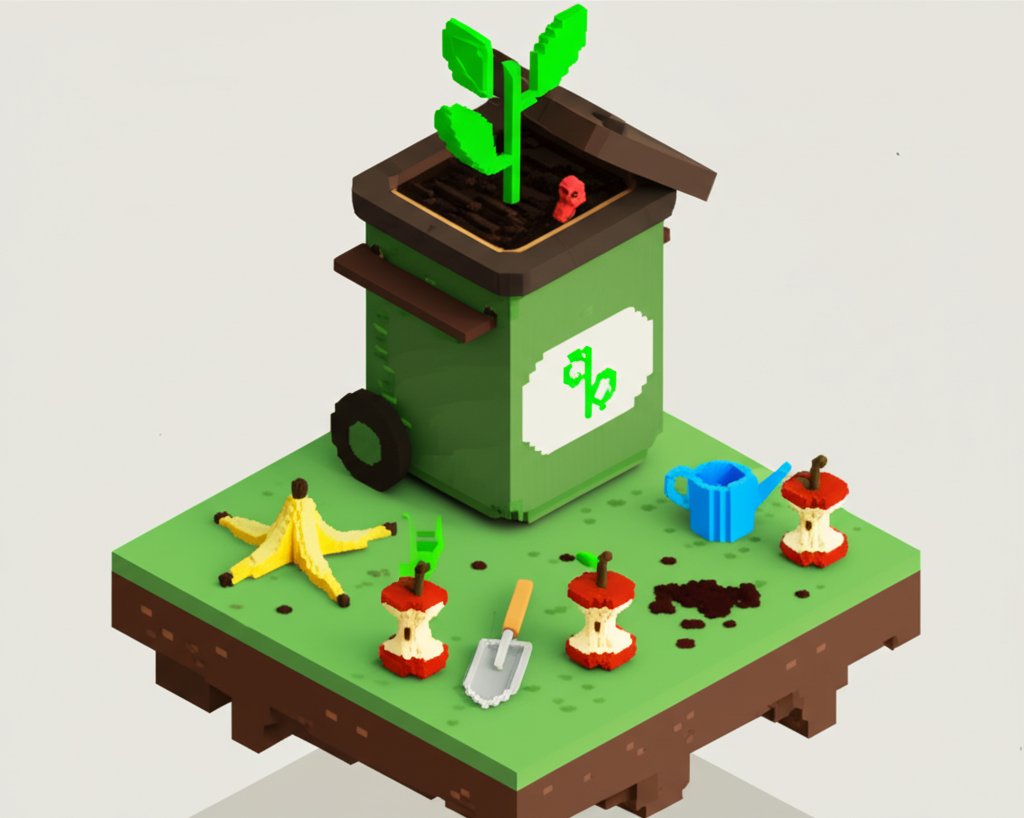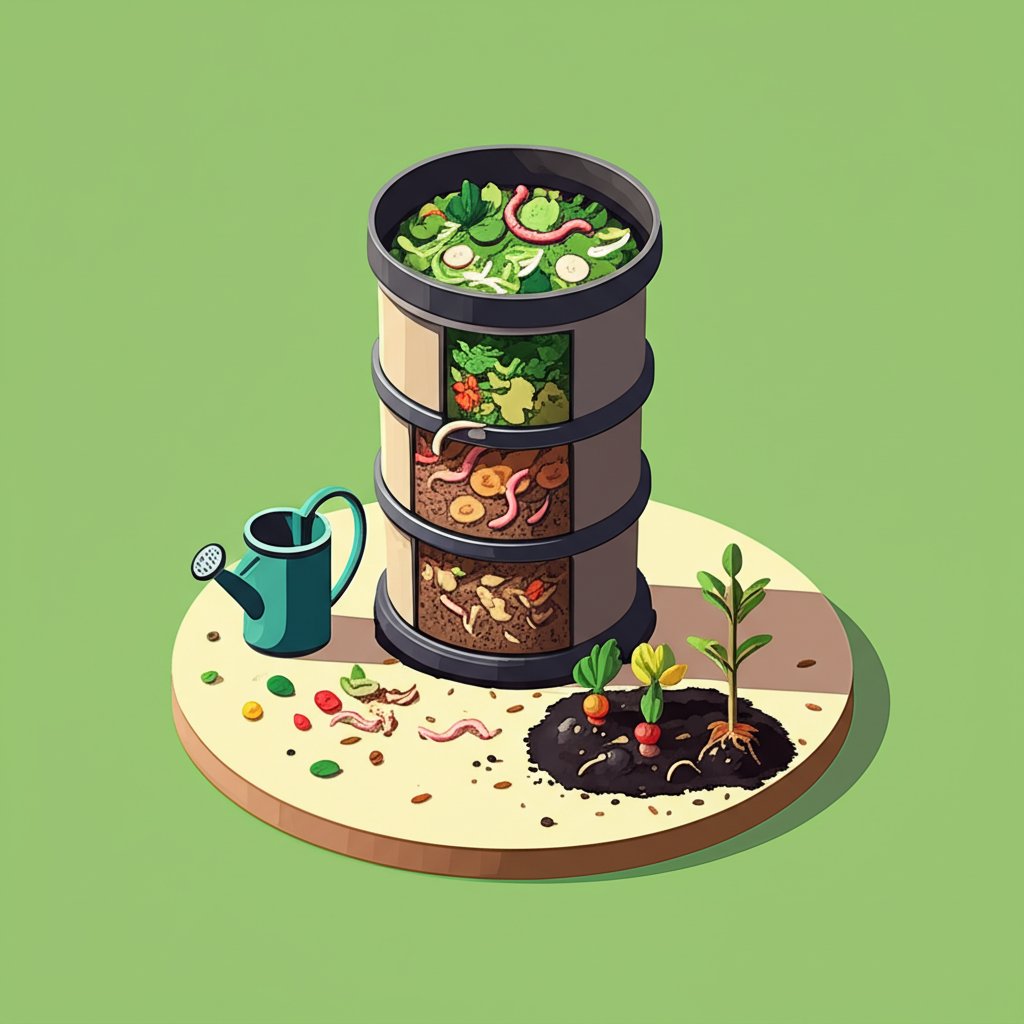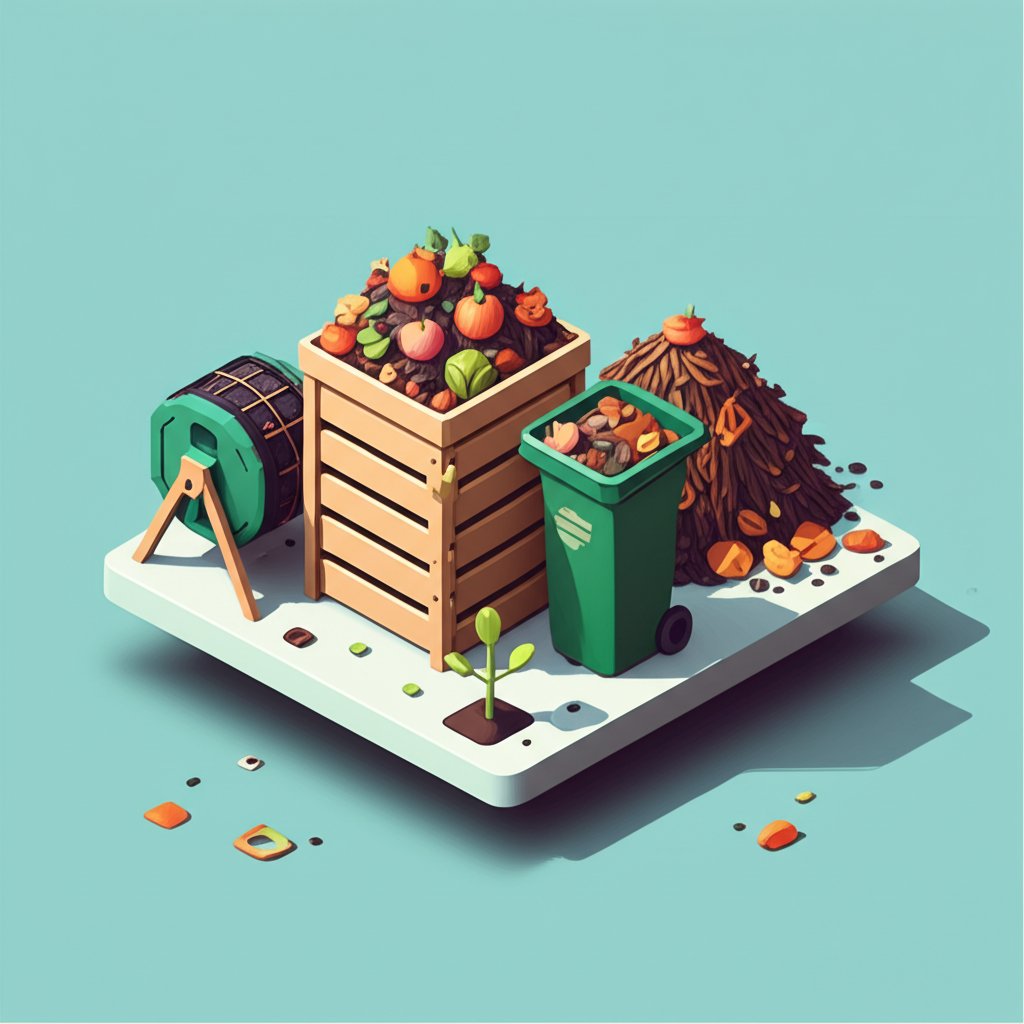Are you ready to transform your kitchen scraps and garden refuse into nutrient-rich “black gold” for your plants? Composting is one of the most powerful and environmentally friendly practices you can adopt, significantly reducing organic waste that clogs landfills while simultaneously enriching your soil. Yet, with a bewildering array of compost bin types available, finding the right one can feel like a daunting task.
This ultimate guide will demystify the world of compost bins, walking you through each type, its unique benefits, ideal use cases, and critical considerations. Whether you’re a seasoned gardener managing acres of land or an urban dweller with a tiny balcony, we’ll help you choose the perfect compost bin to suit your lifestyle, space, and composting goals, turning your organic waste into a valuable, life-giving resource. Prepare to master the art of composting and elevate your garden to new heights!
The Unseen Power of Composting: Beyond Waste Reduction
Before we delve into the mechanics of different compost bin types, let’s reaffirm why composting is a practice every household and gardener should embrace. It’s more than just a hobby; it’s a powerful tool for environmental stewardship, economic savings, and garden vitality.
Drastically Reducing Landfill Waste and Methane Emissions
Globally, organic waste (food scraps, yard trimmings) constitutes a staggering 30-50% of municipal solid waste. When buried without oxygen in landfills, this waste decomposes anaerobically, producing methane – a potent greenhouse gas that is over 25 times more effective at trapping heat than carbon dioxide over a 100-year period. By diverting food scraps and yard waste into a compost bin, you actively reduce landfill volume, mitigate climate change, and ease the burden on waste management systems.
Cultivating Nutrient-Rich Soil: The Black Gold Effect
The primary and most tangible reward of composting is the creation of finished compost. This dark, crumbly, earthy-smelling material is teeming with essential plant nutrients, beneficial microorganisms, and organic matter. When added to soil, compost:
- Improves Soil Structure: Makes heavy clay soils more workable and enhances drainage, while allowing sandy soils to better retain vital moisture and nutrients.
- Boosts Nutrient Availability: Acts as a slow-release fertilizer, enhancing nutrient uptake for plants and significantly reducing the need for synthetic chemical fertilizers.
- Increases Water-Holding Capacity: Leads to more drought-resilient plants, saving water and effort.
- Suppresses Plant Diseases and Pests: Fosters a healthy, diverse soil ecosystem that naturally outcompetes or destroys harmful pathogens and predatory insects.
- Promotes Robust Root Growth: Creates an optimal environment for strong root development, leading to healthier, more vigorous plants.
Fostering a Healthier, Sustainable Environment
Composting at home reduces your household’s carbon footprint, conserves water, and lessens reliance on synthetic chemicals for your garden. It’s a tangible way to participate in a circular economy, transforming what was once considered waste into a valuable, renewable resource. Furthermore, by reducing the need for chemical fertilizers and pesticides, you protect local waterways from runoff pollution and create a safer habitat for beneficial insects and wildlife.
The Science Behind the Soil: Essential Composting Ingredients

Regardless of the compost bin type you choose, successful composting relies on a balanced blend of four essential ingredients, often referred to as the “Greens, Browns, Water, and Air” – or maintaining the optimal Carbon-to-Nitrogen (C:N) ratio.
Greens: The Nitrogen Powerhouses
“Greens” are typically fresh, moist materials rich in nitrogen. Nitrogen provides the “protein” for the rapidly multiplying microorganisms responsible for decomposition. Without enough greens, your pile will be sluggish.
- Examples: Fruit and vegetable scraps, coffee grounds, tea bags, fresh grass clippings, fresh plant trimmings, food waste.
- Role: Fuel for microbial growth, promoting rapid heating and decomposition.
- Composting Tips: Chop larger green materials into smaller pieces to accelerate breakdown.
Browns: The Carbon Backbone
“Browns” are typically dry, woody materials rich in carbon. Carbon provides energy for microorganisms and contributes to the overall bulk, structure, and aeration of the compost pile. Without enough browns, your pile can become slimy and smelly.
- Examples: Dry leaves, straw, shredded newspaper, shredded cardboard, wood chips, sawdust, dried plant stalks.
- Role: Balances the nitrogen, prevents odors, creates air pockets for oxygen, and provides long-term energy for decomposers.
- Composting Tips: Shredding browns significantly speeds up their decomposition.
Water: The Moisture Essential
Composting is a biological process that absolutely requires moisture. The ideal moisture level for your compost bin is similar to a wrung-out sponge – damp to the touch but not soggy.
- Too Dry: Decomposition slows to a halt, as microorganisms cannot function without water.
- Too Wet: The pile can become anaerobic (lacking oxygen), leading to foul odors, attracting pests, and slowing decomposition.
- Composting Tips: Regularly check the moisture level. Add water with a hose or watering can if dry. If too wet, add more dry “brown” materials and turn the pile.
Air: The Oxygen Imperative
The microorganisms involved in healthy composting are aerobic, meaning they require oxygen to thrive. Proper aeration prevents the pile from becoming dense, compacted, and smelly.
- Role: Provides oxygen for aerobic microorganisms, prevents anaerobic conditions, and helps regulate temperature.
- Composting Tips: Turning the compost bin or pile regularly (weekly to monthly) introduces oxygen. Specialized aeration tools can also be used. Many compost bin types are designed with ventilation holes or for easy turning.
Maintaining a balanced ratio of these elements (roughly 2-3 parts browns to 1 part greens by volume) and ensuring adequate moisture and aeration is key to producing high-quality compost rapidly in any compost bin.
Decoding Compost Bin Types: Your Perfect Match Awaits
Now, let’s explore the various compost bin types available, helping you understand their unique features and determine which one aligns best with your composting style, space, and goals. Each type offers distinct advantages and considerations.
1. Stationary (Batch or Holding) Compost Bins
Stationary compost bins, also known as batch compost bins or holding bins, are a popular choice due to their simplicity and relatively low maintenance. These are typically large, single-chamber units where you continuously add organic waste over time.
- How They Work: You load organic waste into the bin, usually from the top, and allow gravity, time, and natural decomposers to do the work. Many have an open bottom to allow direct contact with the soil, inviting beneficial microorganisms, worms, and insects. Some models feature a bottom door for easy compost retrieval.
- Pros:
- Cost-Effective: Often the most affordable option to get started with composting.
- Low Maintenance: Requires minimal turning (though occasional turning speeds up the process).
- Ideal for Beginners: Simple to set up and use, making them excellent entry-level compost bins.
- Critter Resistance: Many models feature lockable lids to deter pests.
- Excellent for Yard Waste: Can handle larger volumes of leaves, grass clippings, and garden debris.
- Cons:
- Slower Process: Decomposition can take several months to a year, especially if not regularly turned.
- Can Attract Pests: If not managed properly (e.g., adding meat/dairy) or if the lid isn’t secure.
- Less Aeration: May require manual turning with a pitchfork or aerator tool.
- Batch Composting: Best used for one large batch at a time, or a continuous slow process.
- Ideal For: Gardeners with moderate to large yards, those producing a steady stream of yard waste and kitchen scraps, and individuals who prefer a “set it and forget it” approach to composting.
- Common Materials: Often made of durable plastic (e.g., the Algreen Soil Saver, Earth Machine) or weather-resistant wood. Wooden versions offer a natural aesthetic and good insulation.
2. Tumbling (Rotary) Compost Bins
Tumbling compost bins are designed for efficiency and speed, perfect for those seeking faster compost production with less physical effort. These sealed, barrel-shaped units are mounted on a frame, allowing them to be rotated, mixing and aerating the compost inside with ease.
- How They Work: You add organic waste through a secure door, seal it, and then rotate the entire barrel periodically (daily or every few days). This mechanical turning evenly distributes moisture and oxygen, significantly accelerating the decomposition process.
- Pros:
- Faster Composting: Can produce finished compost in a few weeks to a few months, depending on conditions.
- Effortless Aeration: Easy turning eliminates manual labor with pitchforks, making composting accessible for all.
- Pest-Proof: The sealed design effectively keeps out rodents, insects, and other unwanted critters.
- Odor Control: The enclosed nature helps contain odors, making them suitable for closer proximity to living spaces.
- Neat and Tidy: No loose piles or mess, making them ideal for smaller yards, patios, or urban settings.
- Cons:
- Higher Cost: Generally more expensive than stationary bins.
- Limited Capacity: Most are smaller in volume, so managing large amounts of waste might require multiple units or frequent emptying batches.
- Weight: Can become very heavy and difficult to turn when full, especially single-chamber models.
- Batch Composting: Often works best as a “batch” system – filling it, allowing it to cook, then emptying it before starting a new batch. Some dual-chamber tumblers allow for continuous use.
- Ideal For: Individuals seeking faster compost production, those with limited space who appreciate a tidy system, and anyone wanting a low-effort way to aerate their compost. Great for processing moderate amounts of kitchen scraps and light yard waste.
3. Worm Compost Bins (Vermicomposting)
Also known as vermicompost bins or worm farms, these specialized compost bin types utilize the incredible power of composting worms (red wigglers are most common) to break down organic waste into a super-rich soil amendment called “worm castings” or “vermicompost.”
- How They Work: Worm bins typically consist of stacked trays with perforated bottoms. You place bedding material (shredded newspaper, cardboard) in the bottom tray, add worms, and then introduce food scraps. The worms eat the organic waste and deposit nutrient-dense castings as they move upwards to new food sources in subsequent trays.
- Pros:
- Highly Potent Compost: Worm castings are exceptionally rich in nutrients, beneficial microbes, and plant growth hormones.
- Indoor/Outdoor Use: Can be kept indoors (kitchen, garage, basement) or outdoors in shaded, temperate areas.
- Excellent for Food Scraps: Specifically designed for kitchen organic waste, reducing household food waste significantly.
- Quiet and Odorless: When properly maintained and fed, worm bins produce no unpleasant smells.
- Educational: A fascinating and engaging way to learn about decomposition for all ages.
- Produces “Compost Tea”: Liquid leachate from worm bins (often called worm tea) can be collected and used as a potent liquid fertilizer.
- Cons:
- Worm Maintenance: Requires some care, including monitoring moisture, temperature, and feeding. Scraps often need to be cut into smaller pieces.
- Not for All Waste: Cannot handle woody materials, dairy, meat, oily foods, or citrus in large quantities, as these can harm worms or attract pests.
- Slower for Large Volumes: Not ideal for processing large quantities of yard waste.
- Temperature Sensitive: Worms are sensitive to extreme heat and cold; year-round indoor operation might be necessary in some climates.
- Ideal For: Apartment dwellers, small households, urban gardeners, classrooms, and anyone primarily looking to compost kitchen food scraps and produce a high-quality soil amendment.
4. In-Ground Compost Bins
In-ground compost bins offer a discreet and integrated composting solution that blends seamlessly into your garden. These bins are partially or fully buried in the soil, with only a lid visible above ground, allowing direct interaction with the earth’s natural decomposers.
- How They Work: A sturdy, perforated cylinder or bin (like a plastic bin or even a terracotta pot) is partially buried in the ground. You add kitchen scraps directly into the bin through the lid. The surrounding soil provides insulation, while soil microorganisms, earthworms, and insects enter through the perforations to break down the organic waste.
- Pros:
- Discreet: Blends seamlessly into the garden or landscape, ideal for those who prefer an unobtrusive system.
- Rodent Resistant: The buried nature makes it much harder for pests to access the food waste.
- Low Odor: Odors are typically absorbed by the surrounding soil, making them very neighbor-friendly.
- No Turning Required: Minimal effort, as nature takes its course with little intervention.
- Adds Nutrients Directly: Slowly releases nutrients into the surrounding soil, enriching the garden bed directly around the bin.
- Consistent Moisture: Less prone to drying out due to ground moisture.
- Cons:
- Slower Decomposition: Often the slowest method, as aeration is limited.
- Difficult to Harvest: Compost is not easily harvested in bulk; it typically enriches the soil directly around the bin.
- Limited Capacity: Best for small, continuous additions of food waste, not large batches of yard waste.
- Installation: Requires digging a hole for initial installation.
- Ideal For: Gardeners who want a subtle composting solution, those with minimal organic waste, and people who prefer to have nutrients directly released into their garden beds for specific plants.
5. Open Piles & 3-Bin Systems
While not strictly “bins,” open compost piles and multi-bay (often 3-bin) systems are traditional and highly effective methods for composting large volumes of organic waste, particularly yard debris.
- How They Work: An open pile is simply a heap of organic waste on the ground. A 3-bin system typically consists of three connected bays made from wood, pallets, or wire mesh. One bin is for adding fresh materials, the second for actively decomposing materials turned from the first, and the third for finishing compost. This allows for continuous composting in stages.
- Pros:
- Unlimited Capacity: Can handle very large volumes of organic waste, making them perfect for extensive gardens or small farms.
- Cost-Effective: Can be built using reclaimed materials like pallets, making them very cheap or free.
- Excellent Aeration: Easy to turn and aerate with a pitchfork due to open design.
- Fast Decomposition (with management): Hot composting can be easily achieved in large, well-managed piles.
- Cons:
- Space Intensive: Requires significant space, unsuitable for small yards or urban settings.
- Aesthetics: Can be less visually appealing than enclosed bins.
- Pest Potential: More prone to attracting pests if not managed carefully (e.g., burying food scraps deep, avoiding meat/dairy).
- Odor Potential: If not balanced or aerated, can become smelly.
- Manual Labor: Requires more physical effort for turning large volumes.
- Ideal For: Large gardens, homesteads, or community gardens with abundant organic waste and space, where efficiency and volume are priorities.
6. Food Waste Digester Bins
These are a specialized sub-category of compost bin types, sometimes overlapping with stationary or in-ground bins, specifically designed to efficiently break down all types of food waste, including cooked food, meat, and dairy, which are often avoided in traditional composting.
- How They Work: Often airtight and sometimes utilizing specific additives (like Bokashi bran) or designs that promote rapid, sometimes anaerobic, decomposition or thermophilic activity. Some combine elements of a traditional bin with a more focused approach to a wider range of organic waste. They effectively “digest” waste, often reducing it to a liquid or a highly reduced volume of material.
- Pros:
- Handles All Food Waste: Can process items usually excluded from home compost bins (meat, dairy, oils, cooked food, bones in some systems).
- Odor Control: Designed to be sealed and prevent smells, making them suitable for residential areas.
- Pest Resistant: Airtight seals deter pests effectively.
- Volume Reduction: Great for significantly reducing the bulk of challenging food scraps.
- Cons:
- Can Be More Expensive: Specialized design and potential additives may increase cost.
- May Not Produce Usable Compost Directly: Some models simply “digest” or break down waste to a liquid or highly reduced volume rather than producing garden-ready compost. The output might need further decomposition in a traditional compost bin or garden soil.
- Specific Microbes/Additives: May require ongoing purchases of specific inoculants.
- Ideal For: Households wanting to compost all their food scraps, even challenging ones, and prioritize waste reduction and odor control, especially where traditional composting of these materials is problematic.
7. Electric Compost Bins (Food Waste Processors)
Electric compost bins are modern kitchen appliances that rapidly break down food waste. It’s important to note these are technically “food waste processors” or “dehydrators” rather than true composters, as they don’t produce finished compost but rather a dried, sterile, and significantly reduced volume of material. This material can then be added to a traditional compost bin or garden soil to decompose further and integrate nutrients.
- How They Work: These machines use electricity to heat, grind, and dehydrate food scraps, significantly reducing their volume (up to 90%) and sterilizing them in a matter of hours. They often include carbon filters to eliminate odors.
- Pros:
- Extremely Fast: Processes food waste in a matter of hours, offering instant gratification.
- Odorless: Integrated filters effectively eliminate smells, perfect for indoor use.
- Compact: Small footprint, usually fits conveniently on a kitchen counter.
- Handles All Food Waste: Can process meat, dairy, bones, and cooked food without issues.
- Significant Volume Reduction: Minimizes the bulk of food waste, making it easier to manage.
- Cons:
- Not True Compost: Produces a dry, sterile material that needs further decomposition in soil or a traditional compost bin to become nutrient-rich compost. It’s a pre-processing step.
- Electricity Consumption: Requires power, increasing energy use and potentially your utility bill.
- High Cost: Significantly more expensive than traditional compost bins.
- No Live Microbes: The heating process kills beneficial microbes present in true compost.
- Ideal For: Urban dwellers, small households, or anyone prioritizing rapid reduction of organic waste volume and odor, especially in apartments or areas where traditional composting isn’t feasible. The processed material can then be added to a community compost pile, in-ground bin, or garden for final breakdown.
8. Hot Compost Bins (Advanced Systems)
Hot composting isn’t necessarily a distinct compost bin type but rather a highly efficient method often implemented within specific bins designed to facilitate and retain high temperatures. These systems aim to quickly break down organic waste by maintaining optimal conditions for thermophilic (heat-loving) bacteria.
- How They Work: These bins are typically well-insulated to retain heat and designed for easy aeration. The key is to achieve and maintain temperatures between 130-160°F (55-70°C) through a precise balance of greens, browns, moisture, and frequent turning. High temperatures kill most weed seeds and pathogens, resulting in a safer, faster product.
- Pros:
- Very Fast: Can produce finished compost in as little as 2-4 weeks with diligent management.
- Kills Pathogens and Weed Seeds: The sustained high heat effectively sterilizes the compost, making it safer for use.
- Produces High-Quality Compost: The resulting compost is often finer, more uniform, and highly beneficial.
- Effective Odor Control: A hot, healthy pile should smell earthy, not putrid.
- Cons:
- Requires More Attention: Demands regular monitoring of temperature and moisture, and frequent turning (every few days is ideal).
- Specific Material Ratios: Needs a precise balance of greens and browns for effective heating.
- Not for Everyone: More involved and knowledge-intensive than passive composting.
- Requires Significant Initial Volume: To generate enough heat, you need a critical mass of materials.
- Ideal For: Experienced composters with a larger volume of organic waste (e.g., from a large garden, small farm, or community project) who desire rapid, high-quality, and sterilized compost and are willing to put in the effort.
Choosing Your Ideal Compost Bin: Key Factors for Success
Selecting the best compost bin for your needs means carefully considering several practical factors. Think about your lifestyle, available resources, and composting goals.
1. Space Availability
- Small Spaces (Balcony, Patio, Indoors): Vermicomposting bins are excellent, compact tumbling composters, or electric food waste processors. In-ground bins are also discreet in a small garden bed.
- Medium Yards: Standard stationary bins or medium-sized tumblers fit well.
- Large Yards/Gardens: Larger stationary bins, multi-bay systems (like 3-bin setups), or even open piles are feasible for significant volumes of organic waste.
2. Volume of Organic Waste Produced
- Small Households (mostly kitchen scraps): Worm bins, small tumblers, in-ground bins, or electric processors are suitable.
- Medium Households (kitchen scraps + some yard waste): Tumbling bins or medium stationary bins can handle this.
- Large Households/Gardeners (lots of kitchen and yard waste): Large stationary bins, wooden bin systems, open piles, or hot composting setups are ideal.
3. Desired Composting Speed
- Fast: Tumbling composters, electric processors (for pre-compost), hot composting systems.
- Moderate: Well-managed stationary bins, active vermicompost bins.
- Slow/Passive: Unattended stationary bins, in-ground bins.
4. Level of Effort and Involvement
- Low Effort: In-ground bins, simple stationary bins (less turning), passively managed open piles.
- Moderate Effort: Tumbling bins (easy turning), worm bins (some care, specific feeding).
- High Effort: Hot composting (frequent turning, temperature monitoring, precise ratios).
5. Budget Constraints
Compost bins range widely in price. Simple plastic stationary bins are often the most affordable, while elaborate multi-chamber tumbling systems, electric processors, or large, custom-built wooden structures can be a significant investment. Consider the long-term benefits, durability, and your commitment level when making a choice. Sometimes, building your own system from recycled materials can be the most budget-friendly option.
6. Critter Resistance
If you’re concerned about rodents or other pests, opt for compost bin types with sealed designs, such as tumbling composters, in-ground systems, or stationary bins with a secure, lockable lid. Worm bins are also generally critter-proof when properly maintained indoors. Proper composting tips also include burying new food scraps deep within the pile and avoiding problem materials.
7. Aesthetics and Odor Control
For visible locations or sensitive noses, consider enclosed tumbling bins, worm bins, or electric processors known for their excellent odor control. In-ground bins are the most discreet option visually. A well-maintained compost pile, regardless of type, should smell earthy, not foul.
Mastering Your Compost Bin: Advanced Tips & Troubleshooting

Once you’ve chosen your perfect compost bin type, here are some essential composting tips and troubleshooting advice for a successful and rewarding journey.
What to Put In (and What to Avoid!)
Understanding what can and cannot go into your compost bin is critical for both efficiency and hygiene.
YES (Greens & Browns):
- Fruit and vegetable scraps: Peels, cores, wilted veggies (chop larger pieces).
- Coffee grounds, tea bags: Excellent nitrogen sources.
- Eggshells (crushed): Adds calcium; crush them for faster breakdown.
- Grass clippings: Great green material; use thin layers to prevent matting and odor.
- Leaves: Superb brown material; shred them for quicker decomposition.
- Shredded newspaper/cardboard: Carbon-rich, avoid glossy paper.
- Wood chips, sawdust (in moderation): Excellent browns, but too much can slow decomposition; balance with greens.
- Plant trimmings (non-diseased): Small branches, spent flowers.
- Hair and pet fur: Small amounts can add nitrogen.
NO (Avoid these in most home compost bins):
- Meat, bones, fish: Attract pests (rodents, flies), create foul odors, decompose slowly, and can harbor pathogens. (Exception: Food waste digesters/electric processors).
- Dairy products: Attract pests, create odors.
- Oils, grease, fatty foods: Attract pests, slow down decomposition, can create anaerobic pockets.
- Diseased plants: Can spread disease to your garden.
- Weeds with seeds: Can spread weeds throughout your garden.
- Pet waste (cat or dog feces): Contains pathogens harmful to humans and should only be composted in specialized, high-temperature systems separate from food gardens.
- Treated wood products: Contain chemicals that are toxic to plants and soil life.
- Non-biodegradable materials: Plastics, glass, metals, synthetic fabrics.
- Coal ash: Contains heavy metals not suitable for compost.
Troubleshooting Common Composting Issues
Even experienced composters encounter issues. Here’s a quick guide to common problems and composting tips for fixing them:
- Smelly Bin (Ammonia or Rotten Egg Smell):
- Cause: Too much “green” material, too wet, or not enough aeration (anaerobic conditions).
- Solution: Add more “browns” (shredded cardboard, dry leaves), turn the pile thoroughly to introduce oxygen, or reduce moisture (if too wet).
- Slow Decomposition:
- Cause: Not enough “greens,” too dry, or insufficient aeration.
- Solution: Add “greens” (grass clippings, food scraps), moisten the pile (like a wrung-out sponge), or turn more frequently to aerate. Chopping materials smaller also helps.
- Pests (Rodents, Flies, Ants):
- Cause: Bin is open, attracting pests with problematic food waste (especially meat/dairy/oily foods), or food scraps are not buried deeply enough.
- Solution: Ensure secure lids, avoid problematic foods, bury food scraps deep within the pile (at least 6-8 inches), or consider pest-resistant compost bin types like tumblers or in-ground bins.
- Compost is Too Dry/Not Heating Up:
- Cause: Lack of moisture, insufficient nitrogen materials, or too small a pile.
- Solution: Add water until it’s damp, add more “greens,” and ensure your pile is large enough to build heat (at least 3x3x3 feet for hot composting).
Harvesting and Using Your Compost
The reward for your composting efforts is rich, dark, earthy-smelling compost. You’ll










